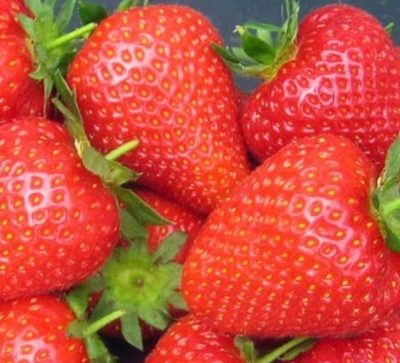
- Authors: Crimea
- Taste: sweet
- The size: very large
- Weight: 25-30 gr
- Repairability: Yes
- Ripening terms: ultra early
- Appointment: fresh consumption, processing (juice, jam, jam, etc.), deep freezing
- Description of the bush: semi-spreading, large, with rich foliage
- Berry color: Red
- Winter hardiness: winter hardy, up to -35 С
The Red Riding Hood strawberry variety was bred on the territory of Crimea in the late 90s of the XX century by crossing the Istochnik and Marieva Makheraukha varieties. It is popular with gardeners because of its large sweet berries and resistance to various diseases.
Description of the variety
For strawberries Little Red Riding Hood is characterized by a semi-spreading large bush about 25 cm high. It has rich foliage of a dark green color. The plant has an average number of outlets. Since Little Red Riding Hood belongs to the remontant varieties, she almost does not form a mustache.
Peduncles are located slightly below the foliage level, there are many inflorescences on them. Up to 10 white flowers appear on one peduncle.
Ripening terms
This variety is characterized by early fruiting times. The first berries ripen in late June and early July. Multiple harvests can be obtained due to remanufacturing. The berries ripen together, fruiting occurs before the onset of frost.
Yield
Little Red Riding Hood is a high-yielding strawberry variety. The bushes bear fruit abundantly throughout the season.
Berries and their taste
Strawberry fruits Red Riding Hood are red in color and oval-rounded. They are characterized by a large size, one berry weighs 25-30 g. The weight of the first berries is up to 35 g, then they become smaller. A few burgundy achenes are weakly impressed into the pulp.
The pulp is juicy and dense, scarlet in color. The variety has a sweet taste and a pleasant strawberry aroma. Berries can be eaten fresh, make jam from them, make juice, freeze.
Growing features
Strawberries Little Red Riding Hood belongs to the winter-hardy varieties and can withstand temperatures down to -35 degrees. However, in the northern regions, she needs a shelter made of spruce branches or straw for the winter. This variety loves moisture and needs periodic watering. It is resistant to diseases and pests. It should also be noted that it is not recommended to grow these strawberries for more than 4-5 years in the same area.




Site selection and soil preparation
The Red Riding Hood variety needs a sunny area with good ventilation. Lowlands and hills are not recommended as a landing site. The soil should be nutritious with normal acidity. Do not plant strawberries after growing tomatoes, potatoes or cabbage.
Planting is carried out from early spring to late autumn. In the spring, in two weeks, humus or rotted manure is introduced into the soil, the same is done before winter, digging up the beds. Wells for young strawberries are watered with warm water, plants are placed in them and covered with earth, leaving the root collar uncovered. It is necessary to maintain a distance of 20-25 cm between plants and 70-80 cm between rows. With a square-nesting method of planting, it should be 50 cm between bushes and rows.

Pollination
Like all remontant varieties, Little Red Riding Hood strawberry has bisexual flowers. Thanks to this, the plant is self-pollinated. This variety does not require any additional pollination for further fruit set.

One of the important techniques in strawberry care is feeding. Regular fertilization guarantees a rich harvest. There are several different ways to feed strawberries, and each of them is designed for a specific period of plant development. During flowering, fruiting and after it, feeding should be different.

Diseases and pests
The Red Riding Hood variety is characterized by good immunity to various diseases of strawberries. But for the purpose of prevention, plants should be treated with biofungicidal agents, for example, "Fitosporin". Often, calendula or marigolds are planted between the rows to prevent diseases and scare off harmful insects. It should be remembered that toxic fungicides are used only before flowering or after harvesting berries.

Strawberries are often subject to many dangerous diseases that can seriously undermine their condition. Among the most common are powdery mildew, gray mold, brown spot, anthracnose and verticillosis. Before buying a variety, you need to inquire about its disease resistance.
Reproduction
Little Red Riding Hood strawberries are not propagated with a mustache, since remontant varieties practically do not form mustaches. You can propagate the variety with seeds or by dividing the bush.
Seeds are planted for seedlings in March-April. Before planting, to increase germination, they should be soaked in water and refrigerated for several days. The soil for cultivation should consist of half of garden soil with the addition of equal parts store soil and sand. You can use a regular plastic container with a lid. The soil in it is moistened, the seeds are distributed from above, without falling asleep. When 5 leaves are formed on the plant, it is dived into a separate container, and 3 weeks after that, it is moved into open ground.
The division of the bush is carried out, as a rule, in the spring.An adult bush is dug up with roots and a sharp disinfected knife is divided into 3 parts with a good root system on each new plant. The young bushes obtained in this way can be immediately planted in the holes.



















































































